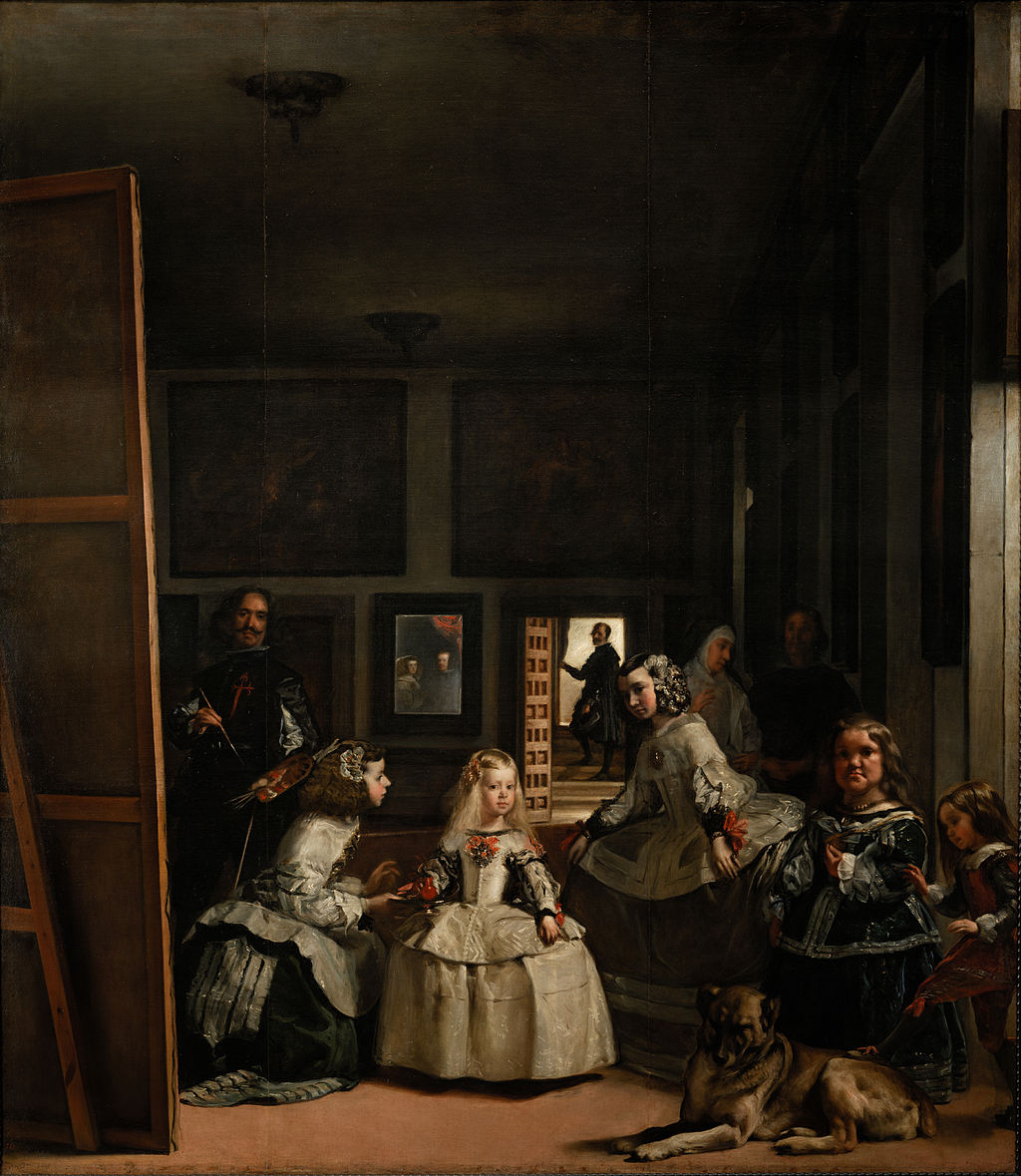An interpretation of "Las Meninas" by Diego Velázquez
See more academic essays

I am writing on one of Velázquez’ most enigmatic works, Las Meninas, commissioned by the court of Philip IV and carried out in 1656. (Levey, Sourcebook, 200). Las Meninas was originally called El Cuadro de La Familia, and is notable for serving as both a family portrait for the king, as well as a self-portrait.
Las Meninas is most noted for its explicit involvement of the viewer in the imagined spacial scene created by the artist. The characters in the painting seem to be by and large preoccupied by an event that would be occuring near to where the viewer is standing. The definitive clue for what is beyond the canvas (both the canvas depicted in the painting and the actual painting itself) is the reflective image of the king of Spain, Philip IV, and the Queen in a mirror on the far wall of the room.The painting sets up a number of tensions created by the involvement of the spectator. Rather than becoming an omniscient but invisible viewer of a scene that occurs solely in front of the viewer, the spectator here is forced to reconcile himself with the gazes of the images on the canvas in front of him. Whereas many of Rubens’ paintings try to create more space on both sides of the canvas frames and away from the viewer-- through the use of expansive ceiling paintings-- Las Meninas actually intrudes forward into the space where the viewer stands. (Martin) The principal “action” of Las Meninas is not spread out before the viewer on a plane that extends laterally, but rather along an axis (or several axes) that pierce right through the painting from “behind.”
There can be said to exist one or two ‘centers’ of the painting. If one considers perspective to be the most important guide, then the center of the painting is where the eye meets the farthest point of intersection of all of the planes-- that is where a courtier is seen in an open doorway, flooded with light. On another level, the center of the painting can be assigned to the center of the space depicted in the painting-- that would be approximately in front of the mirror in the back of the room, underneath the ceiling-light, which would indicate the most likely architectural center of the room There are also two psychological centers of the room: one would place the Infanta Margarita at the center, since she is placed centrally and also happens to be at the apex of a triangle of attendants who are not looking as markedly outward as she is. (Steinberg places this triangle of positioning differently, with the princess, the female dwarf, and the tallest female attendent as the primary triangle, and the other characters in successive posterior triangles, with the apexes lining up approximately.) Finally, there is an imagined center of action of the painting, where the king and queen are standing; we perceive that as the most important center of “action” because it is the impetus of all the gazing and standing around of the characters that we do see. (Steinberg, sourcebook)
Thus perspective and gaze perform together to create ambiguities of “subject.” The effect created is different from that of other “Baroque” paintings, and also from the earlier Mannerist paintings. In the Mannerist style, perspective was not given in any depth, and the crowding of figures into one “plane” helped diffuse the center of focus-- and eliminated the presence of a discrete, psychological “subject”.(Martin) On the other hand, Rubens’ placement of figures in the very close foreground, together with a naturalist style of space-creation, allowed his paintings to have a very clear subject-- and allowed his works to be applied in a propaganda-like fashion in the interest of shaping the images of monarchy. Las Meninas is certainly shows characteristics of naturalism, since it allows us to make conjectures about what is beyond the canvas, as if it were actually there; however, it does so in a way that allows for ambiguities. If there is allegory here, there are no exuberant figures from pagan mythology to indicate what it is; if there is a “point” to the painting, it is masked by the nonchalance and the random-seeming postures and positions of the characters.
As described already, there is a great deal of structure underlying this painting; however, it is undercut by the seeming random placement of the characters. Las Meninas is unconventional for its use of the tools of perspective and gaze-- much in use at the time to achieve psychological ambiguities. The ambiguity of the painting’s center/subject (what and where) creates this feeling of “randomness”. Furthermore, Las Meninas illustrates a characteristic of Valazquez’ paintings that is different from the exuberance of many Counter-Reformation works of Art. In The Old Woman Cooking Eggs and many other of his works, Valazquez no hesitation in portraying the humble, the earthly, or the commonplace. (Martin, 133) Even in paintings where the supernatural encounters the natural, such as in The Fable of Arachne, there is the earthly element. (124) Valazquez can be said to display a more developed naturalism than Rubens, since he not only depicts characters and scenes with rules of perspective and space, but also depicts “natural” scenes.
In Las Meninas, it is curious that the princely power and magnificence so often painted by court painters is not isolated and manipulated with symbols and emblems here. This painting seems as much about the power of art as of the court. Instead of a monarch holding his sceptor, we see the painter with his tool-- a brush. (Levey, Sourcebook, 200) If there are symbols, they are distinctly subtler than those in other works where a guide-book could explain the meaning. (Martin) The symbols are not derived from antiquity, but rather from common knowledge. For example, light flows in and out of the scene in the same way that the gazes do; the pictures on the walls further emphasize the importance of looking. The mirror is most notably symbolic of the way the painting reflects what life in the court must have looked like at a single moment.one can believe that this scene is occuring as it would have in the actual court. Though the structure of the picture still revolves around the royal couple, the couple is highly subordinated visually with respect to the spectator. Even within the scene, the princes, the attendants, and the dog are shown with very little hierarchy. The glass of water offered to the princess is a sign of her importance socially; however, the dwarf woman and the dog are shown with an equal amount of composure and dignity as she. Light is falling upon all of the figures in the forefront evenly, further adding to the “ambiguity of power”.
This subdued style of Las Meninas is characteristic of Valazquez’ other work, and may be a combination of the painter’s status as “the supreme courier-painter of the seventeenth century.” (Levy, Sourcebook p.136) Unlike Rubens, whose court life, political life, personal life, and intellectual life were on different tracks, Valazquez had all of these aspects of his life focused on the court. His first patron was Duke Olivares, whose efforts to reform the Spanish monarchy included a new austerity in the court. Valazquez had many other functions besides painter within the court. (Levey) A combination of the influence of Olivare’s push for a somber, more subtly dignified Spain and Valazquez’ familiarity with the court might have influenced Valazquez’ rather un-extravagant, controlled style. Having seen the court daily, the painter might have less of a tendency to paint exuberant seens of monarchial life. “Perhaps only a painter who had profoundly experienced court life, and seen daily the people he painted, could have reached such truths.” (Levey, Sourcebook p201)
Furthermore, the painting was commissioned in the later years of Valazquez’ career, after the Spanish court had already suffered a number of deaths in the family, and Philip IV was not the triumphant, self-assured monarch he might have been; therefore it is no surprise that this family portrait should attempt to mirror something that the king held dear-- his family-- rather than try to manipulate his image in order to achieve political ends. (Levey). In this sense, the commission was successful in that the portrayal of court life unembellished by emblems of power, wealth, or extravagance was quite in line with Valazquez’ natural style, the aims of Duke Olivares who originally brought him into the court, and the psychological status of Philip IV.
Works Cited
Martin, John. Baroque. Harper and Row, Publishers. New York: 1977.
Levey, Michael. Painting at Court. Sourcebook.
Steinberg, Leo. “Velázquez’ Las Meninas.” Sourcebook.
